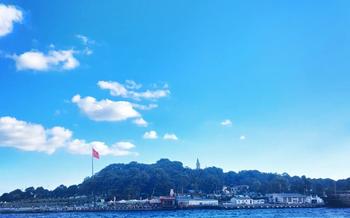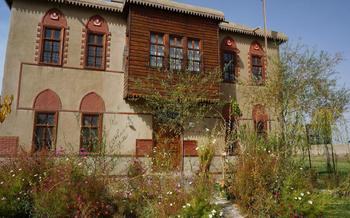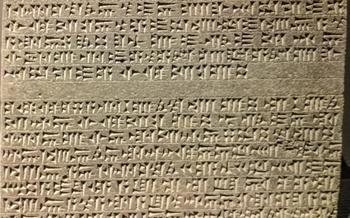
Yoncatepe Inscriptions and Tombs
- Van, Turkey: Unveiling the Wonders of Yoncatepe
- A Journey Through Time: The Yoncatepe Inscriptions
- Exploring the Ancient Tombs of Yoncatepe
- Yoncatepe: A Crossroads of Civilizations
- Transportation to Yoncatepe: A Guide for Visitors
- Admission Fees and Opening Hours: Planning Your Visit
- Unlocking the Mysteries: Guided Tours of Yoncatepe
- Van Museum: A Treasure Trove of Urartian Artifacts
- Local Cuisine: Tantalizing Flavors of Van
- Accommodation Options: Rest and Relaxation in Van
- Photography Tips: Capturing the Essence of Yoncatepe
- Exploring the Region: Day Trips from Van
- Shopping in Van: Unique Souvenirs and Handicrafts
- Insider Tip: Unveiling the Hidden Gem
Van, Turkey: Unveiling the Wonders of Yoncatepe
Yoncatepe, situated in the heart of Van, Turkey, stands as a testament to the rich cultural heritage of the region. This archaeological site boasts a remarkable collection of Urartian inscriptions and tombs, offering a glimpse into the ancient past of this fascinating civilization. Yoncatepe has emerged as a significant destination for history enthusiasts and travelers seeking to delve into the mysteries of ancient Anatolia.
History of the Site Yoncatepe's history can be traced back to the 9th century BC, when it served as a religious and administrative center for the Urartian Kingdom. The Urartians, known for their advanced civilization, left behind a legacy of impressive structures, including temples, palaces, and fortifications. Yoncatepe, with its strategic location on a hilltop overlooking the Van Plain, played a crucial role in the Urartian Empire's defense system.
Archaeological Discoveries Archaeological excavations at Yoncatepe have unearthed a wealth of artifacts, shedding light on the Urartian civilization's daily life, culture, and beliefs. The most notable finds include cuneiform inscriptions, which provide valuable insights into the Urartian language, history, and religious practices.
Importance of the Inscriptions and Tombs The inscriptions of Yoncatepe hold immense historical significance, as they offer a direct window into the minds and thoughts of the Urartian people. These inscriptions often commemorate important events, such as military victories or the construction of royal buildings, providing a narrative of the Urartian kingdom's rise and fall. The tombs, on the other hand, offer a glimpse into the Urartians' burial customs and beliefs about the afterlife.
Tips for Planning Your Visit To make the most of your visit to Yoncatepe, it is essential to plan ahead. Ensure you have comfortable footwear and clothing suitable for exploring the site's uneven terrain. The site is exposed to the elements, so it is advisable to bring sunscreen, a hat, and water. Guided tours are available for a more in-depth understanding of the inscriptions and tombs.
A Journey Through Time: The Yoncatepe Inscriptions
The Yoncatepe inscriptions, etched into the rocky slopes of the Yoncatepe hill, stand as a testament to the rich history and cultural heritage of the Urartian civilization. These inscriptions, written in the Urartian cuneiform script, provide valuable insights into the political, social, and religious aspects of this ancient kingdom.
One of the most significant inscriptions at Yoncatepe is the stele of King Sarduri II, which dates back to the 8th century BC. This stele records the king's military campaigns and his conquests of various regions, shedding light on the extent and power of the Urartian empire. Other inscriptions mention the construction of canals and irrigation systems, highlighting the Urartians' advanced engineering skills.
Deciphering the Urartian cuneiform script has been a challenging task for scholars, but their efforts have gradually unlocked the secrets of this ancient language. Through painstaking analysis and comparison with other known languages, researchers have been able to translate and interpret the inscriptions, providing a wealth of information about Urartian history, mythology, and religious beliefs.
The Yoncatepe inscriptions have played a crucial role in understanding the development and decline of the Urartian civilization. They offer a glimpse into the political and military strategies of the Urartian kings, their interactions with neighboring states, and their cultural and religious practices. These inscriptions have helped to piece together the puzzle of Urartian history, shedding light on one of the most fascinating and enigmatic civilizations of the ancient world.
Exploring the Ancient Tombs of Yoncatepe
Unveiling the mysteries of the past, the tombs of Yoncatepe offer a glimpse into the funerary practices and beliefs of the Urartians. Excavations have revealed a variety of tombs, ranging from simple pit graves to elaborate chamber tombs with multiple burial chambers. These tombs have yielded a wealth of artifacts, including jewelry, pottery, weapons, and bronze objects, providing valuable insights into Urartian craftsmanship and daily life.
The architectural features of the tombs are equally impressive. Constructed using large stone blocks, the tombs often feature vaulted ceilings, niches, and intricate carvings. Some tombs contain elaborate wall paintings depicting scenes from Urartian mythology and daily life, offering a rare glimpse into the artistic traditions of this ancient civilization.
The connection between the tombs and the inscriptions is particularly intriguing. Many of the tombs contain inscriptions that provide information about the deceased, their family lineage, and their accomplishments. These inscriptions have helped scholars to piece together the history of the Urartian kingdom and its ruling dynasties.
Exploring the tombs of Yoncatepe is a journey through time, inviting visitors to connect with the lives and beliefs of the Urartians. Each tomb tells a unique story, revealing the rich cultural heritage of this ancient civilization.
Yoncatepe: A Crossroads of Civilizations
Van's strategic location at the crossroads of Anatolia, Mesopotamia, and the Caucasus made it a melting pot of cultures. The Urartians, who ruled the region in the 9th to 6th centuries BC, were heavily influenced by their neighbors, particularly the Assyrians and Babylonians.
The Yoncatepe inscriptions and tombs provide evidence of this cultural exchange. The Urartians adopted the cuneiform script from the Assyrians, adapting it to their own language. They also borrowed architectural elements from the Babylonians, such as the use of glazed bricks and vaulted ceilings.
Yoncatepe served as a center of cultural exchange, where ideas, technologies, and artistic styles were transmitted between different civilizations. The site's strategic location allowed the Urartians to control trade routes and interact with diverse cultures, resulting in a rich and vibrant society.
This cultural diversity is reflected in the artifacts discovered at Yoncatepe. Excavations have yielded a treasure trove of objects, including jewelry, pottery, weapons, and religious artifacts, showcasing the Urartians' eclectic artistic influences and their role as intermediaries between the cultures of the ancient Near East.
Transportation to Yoncatepe: A Guide for Visitors
Reaching Yoncatepe from Van city center is a convenient and straightforward journey. Public transportation offers a budget-friendly option, with regular buses departing from the city's main bus terminal. These buses provide a scenic ride through the picturesque countryside, allowing you to soak in the region's natural beauty. Alternatively, you can opt for the comfort and flexibility of a private car or taxi. Hiring a car gives you the freedom to explore the surrounding area at your own pace, while taxis offer a convenient door-to-door service. The distance from Van city center to Yoncatepe is approximately 40 kilometers, making it an ideal destination for a day trip or a leisurely exploration.
Admission Fees and Opening Hours: Planning Your Visit
Visiting Yoncatepe is an affordable and accessible experience. The admission fee is nominal, allowing visitors to explore the site's wonders without breaking the bank. The site is open to the public during specific hours, typically from morning until evening. To make the most of your visit, plan your trip during the site's operating hours. Consider visiting during the shoulder seasons (spring and fall) to avoid the summer crowds and enjoy more pleasant weather conditions.
Unlocking the Mysteries: Guided Tours of Yoncatepe
Yoncatepe's intricate inscriptions and tombs are best understood when explored with a knowledgeable guide. Guided tours are available in various languages, providing an immersive experience that brings the ancient site to life. Advance booking is recommended to secure a spot and avoid disappointment.
A guided tour of Yoncatepe offers several advantages. Expert guides provide in-depth explanations of the inscriptions, deciphering the Urartian cuneiform script and revealing the captivating stories they hold. They also offer insights into the burial practices and customs of the Urartians, shedding light on their beliefs and way of life.
Moreover, guides can point out hidden details and features that might go unnoticed by the untrained eye, enhancing the overall understanding and appreciation of the site. They can also provide historical context, explaining the significance of Yoncatepe within the broader context of Urartian civilization and its interactions with neighboring cultures.
With a knowledgeable guide, visitors can delve deeper into the mysteries of Yoncatepe, gaining a comprehensive understanding of its historical, cultural, and archaeological significance. It's an experience that transforms a visit to Yoncatepe from a mere sightseeing trip to an enriching journey through time.
Van Museum: A Treasure Trove of Urartian Artifacts
To fully immerse yourself in the history and culture of the Urartians, a visit to the Van Museum is a must. This treasure trove of artifacts houses a remarkable collection of Urartian relics, including many excavated from Yoncatepe. Here, you can marvel at intricate bronze sculptures, finely crafted jewelry, and stunning ceramics that showcase the artistic prowess of this ancient civilization.
The museum's exhibits provide a comprehensive overview of Urartian life, from their religious beliefs and burial practices to their military conquests and trade networks. Interactive displays and informative panels help bring the Urartian world to life, allowing you to gain a deeper understanding of their rich and complex culture.
Among the highlights of the collection are the impressive bronze cauldrons, intricately decorated with scenes of hunting, warfare, and religious rituals. These cauldrons were used for ceremonial purposes and attest to the Urartians' mastery of metalworking. Equally captivating are the exquisitely carved stone reliefs, depicting mythical creatures, royal processions, and scenes from everyday life.
A visit to the Van Museum is the perfect complement to your exploration of Yoncatepe. Here, you can delve deeper into the fascinating world of the Urartians and gain a comprehensive understanding of their culture and legacy.
Local Cuisine: Tantalizing Flavors of Van
Van's cuisine is a reflection of its rich cultural heritage, influenced by various civilizations that have shaped the region. Indulge your taste buds with a culinary journey, savoring the unique flavors and aromas of local delicacies.
- Must-Try Dishes:
- Van Kahvaltısı: A traditional breakfast spread featuring a variety of cheeses, honey, clotted cream, and local bread.
- İslık Kebabı: Tender lamb meat grilled on skewers, accompanied by grilled vegetables and tangy sauces.
- Van Balığı: A local fish specialty, grilled or baked to perfection and served with lemon and herbs.
- Murtuğa Çorbası: A hearty soup made with local herbs, vegetables, and yogurt, offering a unique blend of flavors.
-
Kaymaklı Ekmek Kadayıfı: A sweet pastry filled with kaymak (clotted cream) and shredded wheat, topped with syrup.
-
Restaurants near Yoncatepe:
- Yoncatepe Restaurant: Located near the site, offers traditional Van cuisine with a view of the inscriptions and tombs.
- Van Kalesi Restaurant: Situated within Van Castle, provides a historic ambiance while savoring local delicacies.
-
Muradiye Çarşısı: A vibrant market area with numerous food stalls and restaurants, offering a variety of local dishes.
-
Unique Ingredients and Cooking Techniques:
- Van Otları: Local herbs and greens, such as keşkek otu (fennel) and sirmo (wild garlic), add distinct flavors to dishes.
- Gavurdağı Salatası: A salad made with dried beef, walnuts, and spices, offering a unique combination of textures and tastes.
-
Tandır Ekmeği: Traditional bread baked in a clay oven, known for its crispy crust and soft interior.
-
Culinary Reflections:
- History and Culture: Van's cuisine reflects the diverse cultural influences that have shaped the region, from the Urartians to the Ottomans.
- Local Ingredients: Dishes often showcase fresh, seasonal ingredients sourced from the surrounding region.
- Hospitality: Food plays an essential role in Van's culture, with meals often shared among family and friends.
Accommodation Options: Rest and Relaxation in Van
After a day of exploring the ancient wonders of Yoncatepe, you'll want to find a comfortable place to rest and recharge. Van offers a range of accommodation options to suit every budget and preference, from cozy guesthouses to luxurious hotels.
For those seeking convenience, there are several hotels and guesthouses located near Yoncatepe. These accommodations offer easy access to the site, allowing you to maximize your time exploring the inscriptions and tombs. Many of these establishments also provide stunning views of the surrounding landscape, making your stay even more enjoyable.
When choosing your accommodation, consider the amenities and services that are important to you. Some hotels offer facilities such as swimming pools, fitness centers, and restaurants, while others prioritize comfort and affordability. It's worth researching and comparing different options to find the perfect place to stay.
To fully immerse yourself in the local culture, consider staying in a traditional guesthouse. These establishments often provide a more authentic experience, with opportunities to interact with local families and learn about their way of life.
No matter your budget or preferences, you'll find a range of accommodation options in Van to suit your needs. Whether you're looking for a comfortable bed and breakfast or a luxurious resort, you'll find the perfect place to rest and prepare for your next day of adventures.
Photography Tips: Capturing the Essence of Yoncatepe
Yoncatepe's ancient inscriptions and tombs offer a unique opportunity for photographers to capture the essence of the Urartian civilization. To ensure your shots are stunning and respectful, consider the following tips:
-
Camera Settings: Use a wide-angle lens to capture the grandeur of the inscriptions and tombs. Set your camera to a low ISO to minimize noise and ensure sharp images. A tripod is recommended for stability, especially in low-light conditions.
-
Lighting: The best time to photograph Yoncatepe is during the golden hours of sunrise and sunset, when the warm light casts a beautiful glow on the site. Avoid harsh midday sun, which can create harsh shadows and overexposed highlights.
-
Panoramic Shots: Take advantage of the expansive views by capturing panoramic shots. Use a panorama mode on your camera or stitch multiple images together using photo editing software.
-
Respect the Site: Remember that Yoncatepe is a historical and cultural site. Be respectful of the inscriptions and tombs by not touching or climbing on them. Use a zoom lens to capture close-up details without disturbing the site.
Exploring the Region: Day Trips from Van
Van, Turkey, offers a wealth of historical and natural attractions beyond the Yoncatepe Inscriptions and Tombs. Embark on day trips to discover the captivating region surrounding Van.
-
Lake Van: A Natural Wonder: Immerse yourself in the beauty of Lake Van, the largest soda lake in the world. Explore its stunning shores, picturesque islands, and ancient monasteries. Take a scenic boat tour to marvel at the unique ecosystem and spot endemic bird species.
-
Cultural Experiences in Traditional Villages: Step into the charming villages nestled amidst the breathtaking landscapes of Van. Experience the warmth of local hospitality, learn about traditional customs, and immerse yourself in the vibrant culture. Visit traditional markets, savor authentic cuisine, and engage with the friendly locals.
-
Historical Sites and Ancient Ruins: Discover the rich history of the region by exploring ancient ruins and historical sites. Visit the Van Fortress, a testament to the city's strategic importance throughout the ages. Explore the medieval Armenian churches, marvel at the Urartian rock carvings at Çavuştepe, and delve into the fascinating history of the region's many civilizations.
-
Itineraries for Day Trips: Plan your day trips from Van to maximize your time and experiences. Consider the following itineraries:
-
Nature and History: Combine a visit to Lake Van with a trip to Çavuştepe, where you can admire the Urartian rock carvings against the backdrop of stunning lake views.
-
Cultural Immersion: Explore traditional villages, such as Gevaş or Çatak, to experience local customs, visit historical sites, and savor delicious regional cuisine.
-
History and Archaeology: Embark on a journey through time by visiting the Van Fortress, the ancient Armenian churches, and the Urartian ruins at Toprakkale. Immerse yourself in the rich history and archaeological wonders of the region.
Shopping in Van: Unique Souvenirs and Handicrafts
In the heart of Van, a vibrant tapestry of colors and textures awaits shoppers eager to discover the city's unique souvenirs and handicrafts. From bustling local markets to charming shops nestled along narrow streets, Van offers a treasure trove of authentic finds.
Delve into the vibrant atmosphere of the local markets, where vendors display an array of handmade goods, from intricate jewelry and colorful textiles to traditional pottery and gleaming copperware. Haggling is a delightful part of the shopping experience, and visitors can often strike great bargains while supporting local artisans.
For those seeking exquisite craftsmanship, the shops of Van showcase a stunning collection of handmade items. Admire the intricate designs and meticulous attention to detail in carpets, kilims, and embroideries, each piece a testament to the region's rich cultural heritage.
When it comes to souvenirs, Van offers a unique selection of items that capture the essence of the city. Look for hand-painted ceramics adorned with motifs inspired by ancient Urartian art, or delicate silver jewelry featuring traditional designs.
Shopping in Van is not just about acquiring souvenirs; it's about connecting with the local culture and supporting the artisans who keep traditional crafts alive. Embrace the vibrant atmosphere, engage with the friendly locals, and discover the hidden treasures that await in this enchanting city.
Insider Tip: Unveiling the Hidden Gem
Beyond the Yoncatepe Inscriptions and Tombs, Van boasts a hidden gem that promises an off-the-beaten-path experience. Nestled in the picturesque countryside, this lesser-known site awaits discovery. Whether it's an ancient ruin, a natural wonder, or a traditional village, this hidden gem offers a unique glimpse into the region's rich history and culture.
To access this hidden gem, you'll need to venture beyond the main tourist routes. Ask locals for directions or seek guidance from your hotel concierge. The journey itself becomes part of the adventure, leading you through charming villages, scenic landscapes, and hidden paths.
Once you arrive at the site, you'll be rewarded with a sense of solitude and the opportunity to explore at your own pace. Immerse yourself in the tranquility of the surroundings, uncover hidden details, and capture stunning photographs without the crowds.
Remember to respect the site's cultural and historical significance. Tread lightly, avoid disturbing the environment, and leave no trace of your visit. Embrace the chance to connect with the region's heritage and discover the hidden treasures that make Van such a captivating destination.









